A seasoned hunter knows that the cost of a hunting lease for a bottomland hardwood forest is always higher than that of an upland pine forest. In fact, watching the first light and then sunrise while duck hunting in a cypress swamp is one of my favorite activities, and is etched into my memory. But why is that?
The habitat conditions and diverse food supply that come with the mix of hardwood species such as oaks, blackgum, sugarberry, sweetgum, ashes, and elms, found in bottomland forests create the ideal environment for a wide variety of wildlife — including both game and non-game species.
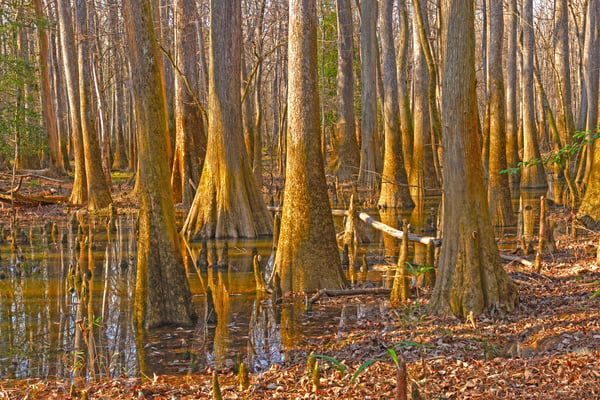
In this article we’ll look at why bottomland hardwoods are so appealing to deer, bears, and birds of all sizes, the timber value of hardwood species, and how you can best manage your bottomland forest for wildlife and sustainable harvesting.
If you own at least 10 acres of forest land in Florida, Wisconsin, South Carolina or Pennsylvania, and are looking for resources to help keep it healthy, click below to find you property on our map and request a free woodland report.
Click below to find your property on our map and get your
free woodland report today!
Let’s back up — what IS a Bottomland Forest exactly?
A bottomland hardwood forest is a suite of trees that grows on low sites, usually on ground made up of soil particles that are deposited by flood water, and is sometimes flooded. Most of the tree species found in bottomland forests are hardwoods, but a few, such as cypress, are conifers. Individual tree species are usually adapted to certain site conditions where they outcompete other species. Soils are usually fertile and many former bottomland hardwood sites have been converted to agricultural land.
The Wildlife of a Bottomland Hardwood Forest?
Hardwood stands are generally more suitable than pine forests for many wildlife species. For instance, in the south, the biggest bucks are grown in the bottoms. Squirrels and wood ducks also thrive in the bottoms, and there are several nongame species such as swallow-tailed kites, and the Prothonotary, Swainson’s, Kentucky, and hooded warbler which breed there.

My son John, Biologist, U.S. Fish and Wildlife Service, releasing a Prothnotary warbler as part of a research project, with my students looking on.
Bottomland hardwoods support very high densities of wintering birds, and in our swamp in Franklin Parish, LA, my son and I are even entertained by a pair of bald eagles which soar protectively over their huge nest atop an old cypress tree.
As Larry Savage, (now retired) Wildlife Biologist with the Louisiana Department of Wildlife and Fisheries, used to always point out to my wildlife students at Louisiana Tech, “tree diversity is good.”
This is because different hardwood species are good for wildlife at different times of the year. For instance, blackgum, sugarberry, sweetgum, ashes, and elms each produce fruit in different seasons, and together, they provide some wildlife with a food supply year-round.
Oaks, which produce acorns with a high carbohydrate (energy) load, support over one hundred species that consume either whole or pieces of acorns. Furthermore, white oaks pollinate their flowers in the spring, and their acorns mature and fall in a single growing season. The acorns of red oaks, on the other hand, take two growing seasons to mature, so a mix of both species is recommended. A bad year for one may still yield acorns from the other. I’ll talk more about which species of oak are best for different types of wildlife later in this post.
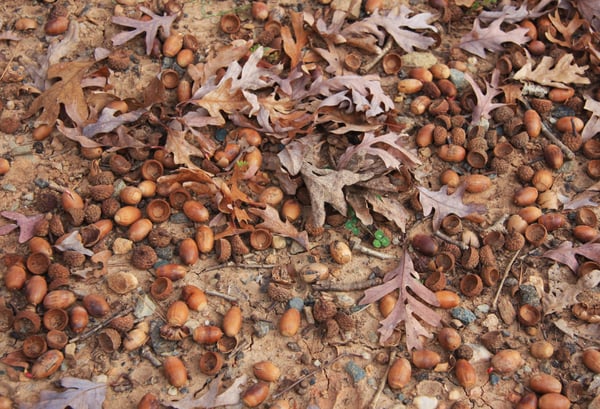
White oak acorns in Duke Forest, NC (credit: Jane Shelby Richardson, Duke University)
Harvesting your Bottomland Hardwoods
Value is inherent in all forest stands. Trees have value as timber, and they tend to grow every year. While maintaining wildlife habitat is often a priority for family landowners, seeing some financial return on their efforts to maintain the health of their woods is also a common objective. Thankfully, recent timber markets are recovering after years in the doldrums.
If you are managing an existing forest stand that is dense with a high basal area, a thinning or small clearcut may be in order—just be sure you have enough volume for a sale. Opening up a stand in this way increases light, thus fruit production from trees and shrubs, and low vegetation which serve as deer browse and turkey brood habitat. You can base part of your tree selection on which species or individual trees have the best value for wildlife.
If considering a regeneration harvest, remember that most tree species have a site, or general soil condition, on which they grow best (or at least better than their competitors.) The following are some recommendations for which species grow best in different soil conditions, and what you could plant where.
Planting Bottomland Hardwoods
If you’ve read my other works, you know my examples are typical of the South. Let’s start from the wettest—often flooded—sites.
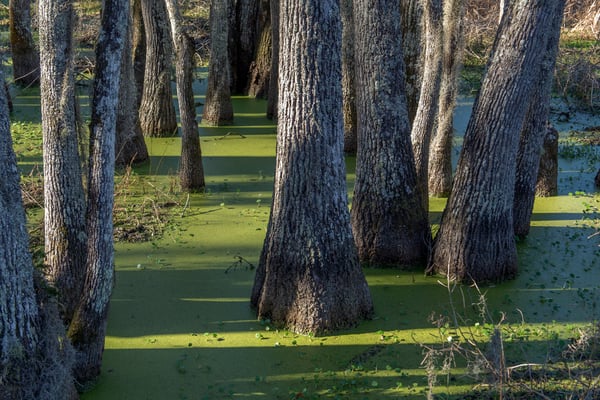
Swamp of duckweed and Tupelo Trees.
First take a look and see what’s already growing, as well as what you may be missing. Look carefully, as deciduous seedlings without their leaves are not so obvious in winter. The good news is, Mother Nature is pretty good at hardwood regeneration, and matching tree species with appropriate sites.
Winter is a good time to work on your woods, without three digit temperatures and those pesky mosquitoes. It’s a good time to repaint boundary trees, mark trees to be cut or left in a harvest, and start your tree planting if that is on your agenda.
A quick note about marking trees for boundaries or a harvest: Be sure the tree in question is dry, and then scrape off any really loose bark where you want to paint.
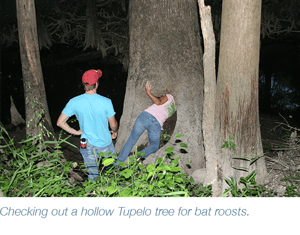
You’ll need seasonally dry ground to get seedlings started, even on the wettest sites. Bald cypress, water tupelo, and black willow will outcompete other species on very wet sites. Leave any old, hollow flat-topped cypress or tupelo, as big, hollow hardwoods are used for denning by Louisiana black bears, nesting by wood ducks, are important to several species of bats, and their fruit is eaten by other wildlife as well.
As you move upslope where there is less frequent flooding, you typically find green ash, bitter pecan, and overcup oak. If you wonder about the name bitter pecan, try one. Apparently that makes no difference to wood ducks—I’ve seen their crops full of bitter pecans!
Overcup oak produce an acorn husk that is extensive and light, so their acorns float. They may have some value for waterfowl with leaf litter and invertebrates in the water, or cavity nesting sites, but the acorn itself is too large for ducks to swallow. Another associate of this group that grows on heavy clay soil in the floodplain of larger rivers is nuttal oak. It has a large striped acorn, but apparently not too large for ducks.
On slightly less flooded sites, is willow oak—also often found on poorly drained clay flats. On more mesic—but still a wide variety of sites—are water oak and cherrybark oak. All of these red oaks have a small acorn that wood ducks and mallards relish.
Meanwhile, cow oak (a white oak,) grows on a higher site in the bottoms such as an old bayou bank. It produces a large acorn, good for deer and squirrels, but whole acorns that are likely too big for ducks.
Getting Financial Help for Managing your Bottomland Hardwood Forest
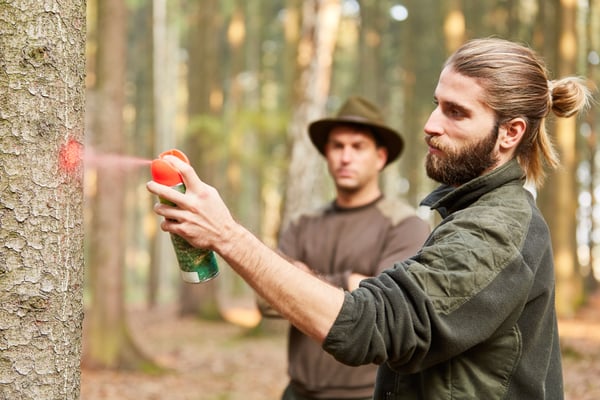
What some landowners don’t realize is that there are funding programs available to help you maintain your woods. WoodsCamp, an online tool of the American Forestry Foundation, uses mapping data to match forest landowners with resources available in their area. Just answer a few questions about your objectives, and help may be on the way.
For instance, landowners in South Carolina can now take advantage of financial assistance for managing bottomland hardwoods with practices such as controlling invasive species, thinning, or carefully planned patch cuts.
To find out if WoodsCamp is live in your state, and what your land might qualify for, click below to find your property on our map.
Spend some time this season in your woods. Enjoy the peace and quiet, and while you’re there, assess what you can do to improve its value for both wildlife as well as timber.
About the Author: Dr. James G. Dickson is an award-winning author, researcher, wildlife biologist, and professor. He, with help from colleagues, produced the comprehensive and award-winning books on: Wildlife of Southern Forests: Biology and Management, and The Wild Turkey: Biology and Management, called the turkey bible. He is Scientist Emeritus, USDA Forest Service, Southern Research Station. Email him at jgdickson14@gmail.com
*This post was written by guest blogger. The views within it do not necessarily represent those of WoodsCamp Technologies or the American Forest Foundation.



We want to hear from you.